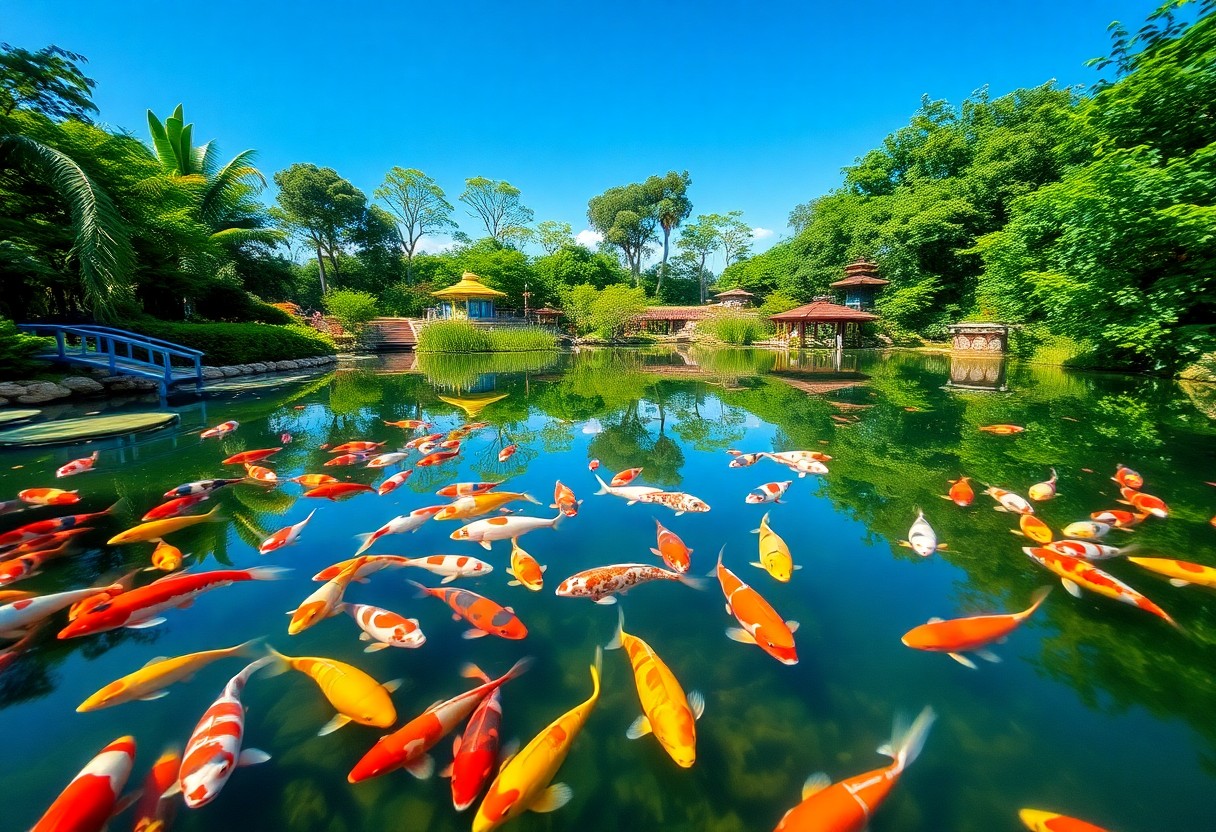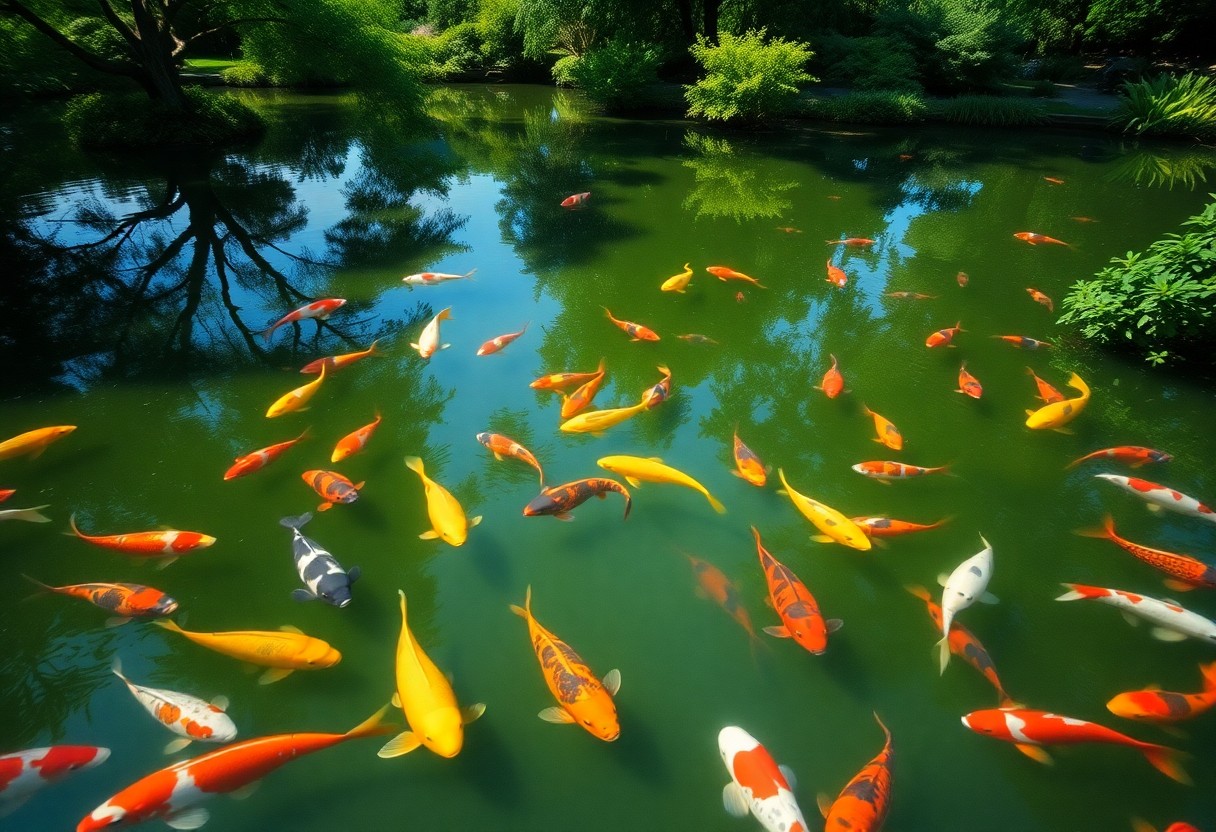Koi fish, known for their vibrant colors and serene presence, have captivated enthusiasts around the globe. You may wonder just how many of these beautiful creatures exist in the world today. Estimates suggest that there are millions of koi fish across various environments, from private ponds to public displays. While high demand has led to extensive breeding, the balance of biodiversity and environmental impact is something you should consider as you explore the fascinating world of koi keeping.
Table of Contents
Key Takeaways:
- The exact number of koi fish in the world is unknown due to their popularity and breeding in various locations.
- Koi fish can be found in ponds, lakes, and aquariums worldwide, contributing to their estimated millions in population.
- Breeding practices in countries like Japan and the United States have increased the diversity and number of koi fish.
- Environmental factors and habitat conditions can influence koi populations in both wild and cultivated settings.
- Koi fish are often kept for ornamental purposes, leading to varying population sizes based on cultural preferences and local demand.

Understanding Koi Fish
Before delving into the fascinating world of koi fish, it’s crucial to recognize their significance in both aquaculture and cultural symbolism. Koi fish are not just ordinary pond dwellers; they are vibrant symbols of prosperity, good fortune, and perseverance. Their captivating colors and patterns make them a favorite among fish enthusiasts, and understanding these creatures better will enhance your appreciation for them.
Origin and History
After centuries of breeding, koi fish have evolved from common carp in Asia. Originally cultivated for their striking colors and patterns, their popularity spread throughout Japan in the early 19th century, where they became integral to the culture, signifying beauty and longevity.
Different Varieties of Koi
To appreciate koi fish fully, you should familiarize yourself with the various varieties. Each type is distinguished by specific patterns and colors, ranging from the vibrant kohaku to the elegant sanke. Collectors often seek out these varieties based on personal preference and the aesthetic of their ponds, which creates a rich diversity among koi enthusiasts worldwide.
At the heart of koi variety appreciation lies knowledge of their distinct patterns and colors. The kohaku features a white base with striking red patterns, while the taisho sanke combines white, red, and black. Then there’s the showa, known for its bold contrast and vibrant mix of colors. Each koi variety exhibits unique characteristics that can influence its value, making it important for you to understand these traits when selecting koi for your collection or pond.
Global Koi Population
You might be curious about the global koi population. Estimates suggest that there are millions of koi fish around the world, making them a popular choice for pond enthusiasts and aquarists alike. For a fun discussion on the subject, check out this How many Koi Fishes are there? There was only 2 at first… thread.
Wild Koi Populations
Between environmental factors and human intervention, wild koi populations are quite rare. Native to East Asia, wild koi can be found in a few bodies of freshwater, largely influenced by habitat conditions and natural selection.
Domesticated Koi Numbers
Wild koi have significantly less representation compared to domesticated koi, which thrive in koi ponds worldwide. Domestication has led to a remarkable diversity of colors and patterns, appealing to collectors and enthusiasts.
Indeed, the number of domesticated koi can be staggering, with some estimates suggesting that they may number in the tens of millions globally. This vibrant population showcases a variety of spectacular colors, breeds, and sizes, largely due to selective breeding for aesthetic qualities. The popularity of koi has also made them a serious business, with koi shows and competitions around the world. While their beauty captivates many, it is necessary to maintain quality care and avoid overcrowding, which can lead to health issues within your koi community.
Major Koi-Producing Regions
Many countries around the world contribute to the koi fish industry, but some regions stand out for their production. Japan is often considered the epicenter of koi breeding due to its long-standing history and cultural significance. Countries like the United States, China, and Thailand have also emerged as significant players in the koi market, expanding your options when it comes to finding and purchasing these ornamental fish.
Japanese Koi Farms
On the lush, green islands of Japan, koi farms thrive, producing meticulously bred fish prized for their beauty and quality. Here, traditional methods combine with innovative practices to ensure that you find a diverse range of stunning color patterns and sizes. These farms often adhere to strict standards, emphasizing the importance of koi lineage, which significantly affects the value and charm of the fish.
International Breeding Centers
Along with Japan, numerous international breeding centers have gained recognition for their high-quality koi production. These facilities, located mostly in the United States and Europe, aim to cater to your growing demand for diverse breeders. They offer unique hybrids and varieties that may not be typically found in Japanese farms, thus giving you a wider selection to choose from.
The rise of international breeding centers has transformed the koi market, making it more accessible for enthusiasts like you. Many of these centers prioritize sustainability and the health of their koi stock, providing a more positive impact on the environment. However, it’s important to do your research, as not all breeding facilities uphold the same high standards. You should look for reputable centers that focus on the ethical breeding of koi, ensuring you find the best fish for your collection.
Factors Affecting Koi Population
Not only do environmental conditions and commercial breeding practices influence koi fish numbers, but several other elements play a significant role. Consider these factors:
- Water quality
- Climate
- Predation
- Habitat destruction
Perceiving these influences can help you better understand and appreciate the dynamics of koi populations.
Commercial Breeding
About commercial breeding significantly impacts koi fish populations. Breeders cultivate various strains to meet market demand, leading to a higher concentration of certain types of koi. This not only affects the genetic diversity within the population but also shapes the overall population numbers globally.
Environmental Conditions
After considering commercial aspects, it’s necessary to examine how environmental conditions influence koi populations. Factors such as water quality, temperature, and the presence of pollutants can either support or hinder fish growth and reproduction.
Factors such as temperature fluctuations and water pollution can have a profound impact on koi survival rates. High temperatures can encourage disease outbreaks, while low water quality can lead to stress and increased mortality. Additionally, habitat degradation from human activities can limit breeding spaces and reduce overall populations. Balancing these conditions is vital for maintaining healthy koi numbers.
Koi Fish Industry
Keep in mind that the koi fish industry is a thriving market, comprising breeders, dealers, and enthusiasts from around the globe. The popularity of Japanese koi has led to innovations in breeding, with factors like color patterns and size influencing their value significantly. This industry not only elevates the appreciation for koi but also contributes to your local and global economies.
Market Demand
Any discussion about the koi fish industry must consider the increasing market demand. With more people embracing koi as both decorative pond fish and symbols of prosperity, your purchasing choices greatly influence breeding trends. Enthusiasts seek unique varieties, which drives prices higher, reflecting their high value in the market.
Economic Impact
Impact of the koi fish industry extends beyond mere sales figures; it fosters various job opportunities and boosts tourism in areas known for koi breeding. Your investment as a consumer encourages sustainable practices among breeders, ensuring long-term viability. Consequently, fostering economic growth within communities engaged in this industry can be vital to their overall health.
Fish farming for koi has become a significant economic activity, creating a network that includes breeders, retailers, and aquarium enthusiasts. The industry contributes to local economies through job creation, as it requires skilled labor in areas such as breeding and maintenance. Moreover, the trade often leads to increased tourism in regions known for koi ponds and exhibitions. By purchasing koi, you support these businesses and help enhance their sustainability, ensuring that the beauty of these fish continues to thrive in your community.
Conservation and Challenges
All around the globe, the population of koi fish faces significant challenges that threaten their survival. Habitat loss, pollution, and overfishing are just a few of the issues impacting koi populations today. As a koi enthusiast, your awareness and understanding of these challenges can contribute to their conservation.
Preservation Efforts
At the forefront of koi conservation, many organizations are implementing initiatives to protect their habitats and promote responsible breeding practices. These efforts include habitat restoration, public education campaigns, and partnerships with local communities to ensure sustainable koi farming. By supporting such initiatives, you can help secure a future for these beautiful fish.
Threats to Population
Challenges to koi populations stem from several factors, including water pollution, invasive species, and climate change. These threats not only harm koi directly but also disrupt their breeding grounds, leading to decreased populations. To safeguard your koi fish, it’s vital to recognize these environmental pressures and support sustainable practices in fishkeeping and habitat conservation.
To address the threats to koi population, it is vital to mitigate water pollution, which deteriorates their habitats and affects their health. Additionally, the introduction of invasive species can lead to competition for resources, complicating koi survival. Climate change poses further risks, altering aquatic ecosystems and impacting breeding patterns. By actively engaging in conservation efforts and promoting awareness, you can play an vital role in ensuring the well-being of koi fish for future generations.
Summing Up
Following this exploration into the population of koi fish globally, you’ll find that while exact numbers remain elusive, their popularity continues to rise across the world. Koi breeding has flourished, resulting in millions of koi fish in ponds, aquaculture, and private collections. As you engage with this vibrant hobby, consider contributing to the conservation and appreciation of these stunning creatures, enriching not only your own experience but also the overall community of koi enthusiasts.
FAQ
Q: How many koi fish are estimated to be in the world?
A: Estimating the exact number of koi fish in the world is quite challenging. However, it’s believed that there are millions of koi fish globally, with significant populations found in countries like Japan, the United States, and various parts of Europe. Japan is particularly known for its koi breeding farms, contributing greatly to the overall population.
Q: What factors influence the population of koi fish worldwide?
A: Several factors influence the population of koi fish, including breeding practices, water quality, pond maintenance, and environmental conditions. Human activities such as koi farming and breeding contribute to the increase in their numbers, while habitat loss and pollution can negatively impact their populations.
Q: Are koi fish primarily bred for specific purposes?
A: Yes, koi fish are often bred for ornamental purposes in garden ponds and water features. They are valued for their beauty and colors, making them popular among aquarists and collectors. Some specific varieties are cultivated for competitions, exhibitions, and even for sale at high prices due to their unique patterns.
Q: How has the popularity of koi fish affected their population?
A: The rising popularity of koi fish has led to increased breeding and farming, resulting in a larger population. While this demand promotes the growth of koi varieties, it may also cause issues related to overbreeding and genetic diversity. Responsible breeding practices are vital to maintaining a healthy population of koi fish.
Q: Could environmental changes impact the number of koi fish in the future?
A: Yes, environmental changes such as climate change, pollution, and habitat destruction can significantly impact koi fish populations. Changes in water temperature and quality can affect their health and breeding habits. Protecting aquatic ecosystems and ensuring clean waterways is important for the future sustainability of koi fish populations around the world.

